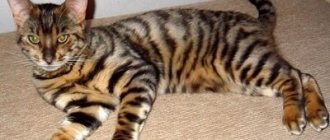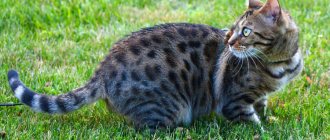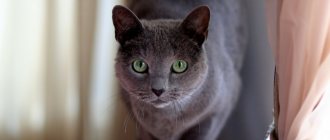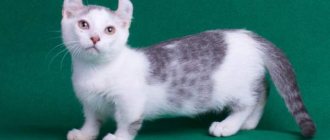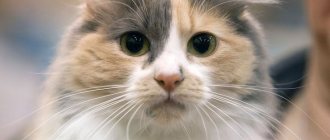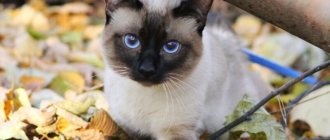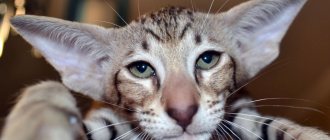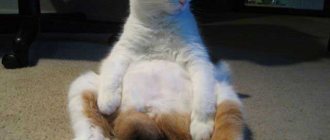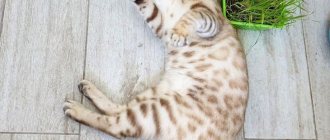What will you learn from the article?
- List of cat breeds without a tail
- Characteristics and classification of tailless breeds
- Cymrics and Manx cats Manx cat
- Cymric
- Kuril
Among several dozen breeds of domestic cats, representatives that are born without a tail stand out. Most of these breeds are called bobtails - from the English. "short-cropped tail." Cats without tails look unusual and have found their admirers.
Tailless cats: history and their types
Felinologists even today cannot agree on how tailless cats appeared. Several versions have been put forward:
- During research work, scientists have repeatedly confirmed the fact that most wild cats gave birth to ordinary babies, but chewed off the kittens’ tails within 24 hours. It is believed that the instinctive ridding of babies from the “weak spot” eventually led to a natural mutation and the animals became short-tailed.
- A natural mutation without prerequisites such as biting off the tail, which led to short tails.
- The third version applies only to American bobtails and pixie bobs. Many believe that these cats descended from lynxes themselves.
A distinctive feature of all tailless cats is their short tail.
Types of tailings
Conventionally, all tailless cats can be divided into two groups: Manx and Bobtail (except for the Pixie Bob and American Bobtail, whose tails should be as close as possible to a lynx). Each of them has its own tail classifications:
- Manx: Rumpy or Dimple Rumpy are the most highly prized cats. Their tail is completely absent; in the place of its growth there is a small hole. Usually it is cats like rumpy that receive titles at shows.
- Riser or rampy riser - their tail consists of 1-3 vertebrae. Such cats can participate in exhibitions if the tail does not exceed 2–4 cm in length.
- Stumpy - from 4 to 14 vertebrae, often lumpy and knobby.
- Longs or tails. The tail is almost the same length as that of tailed cats. Often the tail has to be docked, since the vertebral discs of long-haired cats can ossify.
- Stump:
- from 2 to 8 vertebrae;
- from 4 to 15 vertebrae;
- consists of 5–11 vertebrae;
- the beginning of the tail (approximately 5–7 vertebrae) is identical in structure to the tail of a simple cat;
Photo gallery: types of tails
Cats with a retracted bobtail do not participate in exhibitions
Cats with a tail (or rather, lack thereof) like rumpy are valued the most
The tail-broom looks like a big fluffy pom-pom
The stump tail is characteristic only of bobtails.
The riser-type tail is almost invisible
A stumpy tail is considered a fault.
The longi tail type is similar to a regular tail.
The spiral tail should be well feathered
American Bobtail
The ancestor of the American Bobtail was the same kitten from an Indian reservation. The cub's name was Yodi. In the early 70s, the foundling already had numerous offspring, who regularly took part in exhibitions.
Scientists from all over the world paid attention to the new breed. People were surprised when they looked at cats without tails. Many considered them inferior. And only in the 90s, a new breed of exotic cats was officially registered, called the “American Bobtail”. Today, getting such a handsome man is the dream of many. The cat is truly beautiful.
She is athletically built and has thick and fluffy fur. The length of the villi varies: from insignificant to medium. It’s not like these cats don’t have a tail at all. It is there, but looks more like a stump. The American bobsled breed boasts a soft, accommodating character. The animal becomes a full-fledged member of the family and becomes seriously attached to everyone at home. Bobsleigh is a great companion for children.
Caring for tailless cats
Tailless cats do not require special care. However, owners should remember a few nuances:
- Tailless cats are prone to infections of the anus and may have difficulty going to the toilet, so the owner should not only closely monitor the well-being of the pet on the tray, but also wipe the cat’s area around the anus after each visit to the tray;
- care for the coat of these cats varies depending on the variety (long-haired/short-haired): each cat will need a rubber brush, a combination comb, a furminator and a bristle brush; short-haired dogs are combed 2 times a week (during the molting period - 4-5 times and 1 time with a furminator), long-haired dogs - 3-4 times a week (during molting - every day and once with a furminator);
Tailless cats are easy to care for
- Regular cleaning of the ears (every 5 days) and daily wiping of the eyes with a natural damp cloth are mandatory, as is trimming the nails.
Toy-bob (skif-toy-bob, skif-tay-don, skiff-tay-toy-don)
Toy-bob history of the breed: In 1988, in a Rostov nursery, a dwarf bob-tailed kitten, Kutsy, was born to two Mekong bobtails, and he laid the foundation for a new breed - dwarf Thai bobtails, toy-bobs.
In 2009, toy beans were partially recognized by TICA.
Toy Bob Personality: Toy Bobs are affectionate, sociable and playful.
Health Features of Tailless Cats
In general, tailless cats are in good health: they rarely get colds and are not susceptible to heart disease or infections. But some risk areas are still present.
Bobtails are susceptible to some diseases, but they rarely occur.
Diseases and defects
Genetic diseases are unfamiliar to tailless cats, but acquired ones occur due to the structure of the body and the characteristics of the organism:
- Proctitis (inflammation of the anus) occurs due to the structure of the tail, under which dirt and fecal particles can accumulate, leading to inflammation. It is treated with medications or surgery, depending on the severity and depth of spread.
- Urolithiasis disease. Mostly, Kurilian and Karelian bobtails get sick due to the different acidity of their urine. If your pet frequently urinates bloody urine, experiences pain when going to the toilet and refuses to eat, this is a sure sign of illness. Stones are removed surgically.
- Manx syndrome, or Manx syndrome. Manx and Cymric cats are susceptible to it. In the first 4 months of life, tailless kittens may develop abnormal spine development. This is followed by spina bifida, hernia, difficulty moving and other problems. The defect cannot be treated.
- In general, tailless cats are prone to spinal problems such as lordosis. But, fortunately, they happen rarely.
A feature of all tailless cats is their elongated hind legs (always longer than the front ones). They developed this unusual feature to maintain body balance without a tail.
Kurilian Bobtail
Another breed of tailless cats bred in Russia is the Kuril Bobtail. Officially registered in 2004. It is impossible to say that these cats have no tail at all. It is replaced by a short process. It can be spiral-shaped, similar to a stump or broom.
© shutterstock
The breed was the fruit of love between a Japanese bobtail and a Siberian cat that was once brought to the Kuril Islands. Their offspring took all the best from their parents. These cats differ from many others not only in the absence of a full tail, but also:
- active, lively character;
- enviable mobility;
- insatiable curiosity.
Such traits make them similar in character to a dog. Cats are famous for their "talkativeness." This breed cannot be crossed with others.
Tailless cat breeds
As already mentioned, all tailless cats can be divided into two types: Manx and Bobtail, on the basis of which various breed variations arose.
Manx
The Manx cat is native to the Isle of Man in Great Britain. There are several versions of the origin of this breed:
- The Manx cat became tailless when it was the last one to run into Noah's Ark: the closing door cut off its tail.
- The Manx cat is descended from the Norwegian Forest cat, which was brought to Maine to kill mice.
Manx cats are originally from the Isle of Man.
- Cats chewed off the tails of their kittens so that the Vikings would not cut them off: for them, a cat's tail was a talisman in battle.
- Manx is the result of crossing a rabbit and a cat.
- The most likely version: Manx taillessness is the result of a gene mutation.
It is believed that Manx cats are the progenitors of all tailless cats.
The breed standard was adopted by the CFA in 1920. Distinctive external features of Manx:
- cheeks round and saggy;
- the head is round;
- the body is massive;
- the coat is short, with a dense undercoat;
- the tail is absent or present in the form of a stump of 2–4 cm;
- If there is a tail, small creases and knots are allowed on it.
The psyche and character of the Manx are formed before the age of 5. This is a loyal and affectionate cat, loves games, is active, but not mischievous. Manxes love children and even protect them from danger. The price for Manx starts at 60,000 rubles.
Video: about the Manx breed
Cymric
The breed originated in Canada and was recognized by the CFA in 1976. The Cymric was originally considered a long-haired version of the Manx. These cats were taken from Maine to Wales, then to Canada, where their selection began. During selection, it turned out that in Cymrics the tailless gene is recessive, while in Manx it is dominant. Therefore, they cannot belong to the same breed. The Cymric is considered Canada's national breed. The main difference from the Manx is the long, shaggy coat with a denser undercoat. Also, the cheeks of the Cymric are even more saggy and resemble lynx “whiskers”.
Previously, the Cymric was considered a long-haired version of the Manx.
Due to the lack of a tail, Cymrics do not exactly run: their movements resemble the jumping of a hare.
The character of the Cymric is influenced by the fact that these cats previously served as guards. They are ready to literally do anything to protect their owner; because of this, Cymrics do not get along with other animals at all. Cymrics love to climb tall objects. They are friendly to children and love affection and sleep. Price - from 100,000 rubles.
Pixie bob
In 1985–1986, an American breeder found two kittens with short tails. One of them was close to a lynx in color and size. Their mating resulted in a cat named Pixie. She became the ancestor of pixie bobs. The breed was recognized by TICA in 1993.
Pixie Bobs were created to look like miniature bobcats
Pixie Bob is a polydact breed (individuals are born with extra toes on their paws). The standard is 5 to 7 toes on the front paws.
The need for movement is very high, the pixie-bob must be walked on a leash. They are very smart and cunning and love to learn. External data:
- shoulders, arch of the back and shoulder blades are clearly visible;
- tail no lower than the hock joint and no shorter than 5 cm, with a tassel at the tip;
- there may be extra toes on the paws, the cat does not rely on them while walking;
- on the ears there are black tassels;
- The color is as close as possible to lynx.
The price ranges from 20,000 to 100,000 rubles.
Kurilian Bobtail
The Kuril Bobtail is an indigenous breed that was formed in the harsh conditions of the Kuril Islands. In the early 1950s, the military brought Kuril shorttails to mainland Russia. There, breeders became interested in them and carried out a minimal selection of the breed. In 1995, the WCF adopted a breed standard. External characteristics:
- long or semi-long thick coat with sparse undercoat;
- tail no shorter than 3 and no longer than 9 cm;
- the muzzle is wedge-shaped, wide and short;
- The body is massive, there are small tassels on the ears.
Kurilian Bobtails are relatives of the Siberian cat.
A self-confident, independent and self-sufficient pet does not consider a person to be the master or a higher being. The key to warm and friendly relations with representatives of this breed is mutual respect and communication as equals. The Kurilian Bobtail is a cat with a reinforced concrete psyche, calm and fearless. They calmly tolerate loneliness and are not inclined to impose themselves.
The Kurilian Bobtail calmly tolerates loneliness and demands respect for itself.
The price of Kurils is from 10,000 rubles.
Video: features of Kurilian Bobtails
American Bobtail
Tourists vacationing in Southern Arizona near a former Indian settlement discovered a kitten with a short tail, which was taken in by a young couple. In their family there lived a Siamese cat, with which he was crossed. The offspring included several kittens with short tails. They were given to professional breeders. As a result of crossing them and their father with Ragdolls, Siamese, Manx, Burmese and mongrel cats, the American Bobtail was developed.
The American Bobtail may well be a descendant of the lynx
There is a high probability that the ancestors of the kitten found in Arizona included a bobcat.
However, by the 1980s the breed had almost disappeared. To restore bobtails, they began to cross them only with cats that had a natural mutation of a shortened tail.
In 2000, when the breed was recognized by the CFA, there were only 215 American Bobtails. External features of American Bobtails:
- eyebrows are expressive and protruding;
- eyes are deep-set, yellow or green;
- tabby pattern, the main color of the coat is from cream to brown-red, tabby stripes are black or brown.
They are very active, can be mischievous if there is a lack of movement and play, and they need a lot of different toys. An interesting feature is that they easily learn to open locks and do not like locked doors. They are usually friendly towards other animals, but often fight for dominance in the “pack”. They do not tolerate loneliness and moving well. Price - 10,000–30,000 rubles.
Video: about the American Bobtail
Japanese Bobtail
The true origin of the Japanese Bobtail is unknown. The first mention of this aboriginal breed dates back to the 12th century. In 1968, several kittens were taken from Japan to the United States. A selection was carried out there and three years later the breed was recognized.
In Japan, tailless cats were considered symbols of happiness and good luck. Bobtails were immortalized in figurines called maneki-neko. And tailed purrs were considered servants of dark forces and underwent tail docking surgery.
Japanese Bobtails bring good luck to owners
Japanese Botails are unusually good-natured, they are people-oriented, devoted to their owner and his entire family. Cats love traveling and can withstand stressful situations. External features:
- light and refined body;
- long thin paws;
- short, thin coat with almost no undercoat;
- the tail is well furred;
- the ability to bend and straighten the tail, when bent it is no longer than 8 cm, when straightened it is no more than 15 cm;
- Van, bicolor and tricolor colors are preferred.
The price of Japanese bobtails is 15,000–75,000 rubles.
Video: about the Japanese Bobtail
Mekong Bobtail
Short-tailed cats were often found among the cats that lived in Thailand in the 15th–19th centuries. After the future Siamese were brought to Europe, these cats were considered “rejected” and decided not to be allowed into selection. In Russia, they became interested in unusual cats and, through selection, developed a new breed, which was recognized as native Russian. The breed received WCF recognition in 2004.
Mekong Bobtails are relatives of the Thai and Siamese
It is said that the tails of the Mekongs became curled and shortened when they guarded ancient vases in palaces and temples with their tails wrapped around them.
Mekongs are very curious, they are the main “activists” in the family, they are very talkative and open cats who love affection. They have a negative attitude towards strangers and do not like other animals, but provided they are friendly, they get along quite well with them.
Mandatory external characteristics:
- only color-point colors;
- Thai cat body type;
- exclusively blue eye color;
- the tail must be wrapped in a donut shape.
Price - from 4,000 to 20,000 rubles.
Video: Mekong Bobtails
Karelian Bobtail
Karelian Bobtails are an indigenous breed that has lived for a long time on the shores of Lake Ladoga. They were noticed and brought to St. Petersburg in 1987. The selection lasted 7 years, after which the breed was recognized by the WCF.
They are very social, get along easily with children and animals, but can be demonstratively offended. Karelians often take on the role of guard and “head of the family.”
Unfortunately, the Karelian Bobtail is an endangered breed
Male Karelian bobtails do not mark, and females go into heat almost unnoticed.
External differences:
- the hair on the tail is longer than the hair on the body, creating the appearance of a pompom;
- the head is round and massive;
- the forehead and cheekbones are high, and the cheeks are “flat”.
Price - from 35,000 to 70,000 rubles.
Table: comparative characteristics of tailless breeds
| Characteristic | Manx | Cymric | Pixie bob | Kurilian Bobtail | American Bobtail | Japanese Bobtail | Mekong Bobtail | Karelian Bobtail |
| Height | From 27 to 32 cm | From 27 to 30 cm | From 25 to 33 cm | From 25 to 30 cm | From 30 to 33 cm | From 23 to 28 cm | OK. 23–28 cm | From 23 to 29 cm |
| Weight | From 3.5 to 7 kg | From 3.5 to 6 kg | From 5 to 9 kg | From 5 to 8 kg | From 3 to 8 kg | From 3 to 4 kg | From 4 to 6 kg | From 2.5 to 6 kg |
| Lifespan | 12–15 years | 15–16 years old | 13–15 years old | 15–17 years old | 14–17 years old | 15–17 years old | 18–20 years old | 10–13 years |
Japanese Bobtail
The Japanese Bobtail was bred in the Land of the Rising Sun. From time immemorial, indigenous people have had a special relationship with cats. In Japanese national culture, it was customary to consider four-legged “girlfriends” of the devil. According to beliefs, it was in the tail that evil spirits lurked.
© shutterstock
People shunned these animals and even destroyed them. In 1968, a tailless breed was developed in Japan, and many rejoiced. “Clean” kittens were sold like “hot cakes.” The breed without a tail was admired and proud. She became an object of worship. It is believed that such cats bring good luck and wealth.
Representatives of this type of bobtail can have any color. Their fur is silky, very pleasant to the touch, although short. Body size is medium. Like the “American,” the “Japanese” is flexible, friendly and obedient. Both adults and children adore him.
Hybrid and wild tailless cats
Hybrid tailless animals are the result of crossing several breeds. They have not yet received recognition, so little is known about them. The list of hybrids is small:
- Alaskan snow cat, or snow bob, is a white variation of the American bobtail;
- Scythian-toy-bob is a Russian breed of miniature cats, a descendant of the Mekong Bobtail and cats with the miniature gene, distinguished by its color-point color;
- oohee-bob - the result of crossing a Siamese and a Manxam - as a result, the color-point Manx was obtained;
- The Highlander is the most unusual short-tailed cat, obtained from crossing an American Curl and an American Bobtail, and inherited a short tail and curled ears from its parents.
Photo gallery: hybrid short-tailed cats
Snow beans are born quite rarely
Compared to an ordinary cat, the Scythe-toy-bob is a real baby
The Oohee Bob is a type of American Bobtail.
The Highlander cat has a short tail and Curl ears.
The wild family of short-tailed cats is limited to lynxes and caracals. There are the following types of lynx:
- Iberian (Pyrenean) lynx;
- Canadian lynx;
- red lynx;
- common lynx.
Photo gallery: wild short-tailed cats
The second name for caracal is steppe lynx
The Iberian lynx is one of the rarest mammals on the planet
The common lynx is listed in the Red Book of Russia
The Latin name for the red lynx is Lynx Rufus.
The Canadian lynx has a silver coat with a reddish tint.
Video: facts about lynxes
Mekong Bobtail
The Mekong Bobtail was bred by the Russians. Among his ancestors are the inhabitants of sacred Siam. Another name for the variety is Thai Bobtail. Features of this breed are :
- the impossibility of finding two representatives with the same configuration of processes that these cats have instead of a tail;
- a tendency to longevity (some individuals manage to celebrate their 25th anniversary);
- pronounced prettiness (rounded lines of the body, bright blue eyes).
The descendants of the Sinai have much in common with the Thai breed, which explains their second name. These are companion cats. A real find for people suffering from loneliness.
